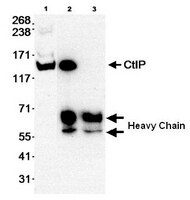AP1046 Sigma-AldrichAnti-CtIP Rabbit pAb
Recommended Products
Overview
| Replacement Information |
|---|
Key Spec Table
| Host |
|---|
| Rb |
| Product Information | |
|---|---|
| Form | Liquid |
| Formulation | In Tris citrate/phosphate buffer, pH 7-8. |
| Positive control | MCF7 cells |
| Preservative | ≤0.1% sodium azide |
| Physicochemical Information |
|---|
| Dimensions |
|---|
| Materials Information |
|---|
| Toxicological Information |
|---|
| Safety Information according to GHS |
|---|
| Safety Information |
|---|
| Product Usage Statements |
|---|
| Packaging Information |
|---|
| Transport Information |
|---|
| Supplemental Information |
|---|
| Specifications |
|---|
| Global Trade Item Number | |
|---|---|
| Catalogue Number | GTIN |
| AP1046 | 0 |
Documentation
Anti-CtIP Rabbit pAb Certificates of Analysis
| Title | Lot Number |
|---|---|
| AP1046 |
References
| Reference overview |
|---|
| Chen, P.L., et al. 2005. Mol. Cell Biol. 25, 3535. Yu, X. and Chen, J. 2004. Mol. Cell Biol. 24, 9478. Germani, A., et al. 2003. Oncogene 22, 8845. Li, S., et al. 2000. Nature 406, 210. Wong, A.K., et al. 1998. Oncogene 17, 2279. |








